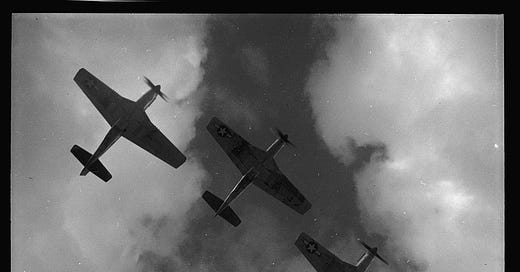Time Travel
#163: Time Travel (WWII/1970s); Elsa Valmidiano, Tenzing Rigdol, Elizabeth Showarchert, Tatay Ete, Ememem, David Wilson; Ben&Ben and The Brothers Comatose with AJ Lee
THEN & NOW

Time Travel
A lot of military jets have been flying overhead today. Yesterday, a group of six jets in formation roared over the town, and there will probably be more, because it’s Salinas Airshow weekend. The jets are pretty awesome in their display of power. But I couldn’t help but think of the news reports of Israel’s current airstrikes on Gaza and Lebanon. And with my epistolary project in mind, I also thought about Manila during the last days of WWII. In fact, an article by Peter S. Mansoor for the Hoover Institution suggests that the Battle of Manila has some parallels to the Israel/Gaza conflict, due to similar size and scope.
From the very beginning of the Pacific war, my father’s employment in the galleys of hospital and transport ships had exposed him to the sight of wounded and dead soldiers and refugees. He was on one of the first hospital ships sent to Pearl Harbor right after the Japanese attack.

A few years later, when his ship docked in Manila right after liberation, he had some free time to walk around the city and witness for himself the changes and destruction that the Battle of Manila had wrought. Although he was born in Mindanao, by then he had been to Manila, “The Pearl of the Orient,” a few times, so the changes must’ve been disorienting.
He struck up a random conversation with a man on a street corner—who happened to be my maternal uncle Vicente (nicknamed Ente). Perhaps Dad had asked him for directions, or wanted to know what happened to a certain building. I imagine it was easy to strike up a conversation in those days. With everything in limbo, there were many questions to be asked. Uncle Ente invited Dad over to the house—which is where he met my mother. I’ve written about what followed in “Romance Among the Ruins.”
I still have a little trouble imagining how that could happen—how people could so quickly pick themselves up after the near total destruction of their city, and carry on with hope for the future. But what else could they do? I don’t want to talk about “resilience,” because I know there was a lot of trauma that would be tamped down and hidden in the efforts to rebuild.1
Flash forward decades later to the 1970s. I’m a hippie, more or less, living in a seaside town with my husband and son in a rented 1920s-era white clapboard house with a huge back yard. The original owners had planted fruit trees all around the perimeter, which are still producing fruit that we gratefully harvest in the Fall.
Reading material in the house includes the Whole Earth Catalogue, Carlos Castaneda’s The Teachings of Don Juan: A Yaqui Way of Knowledge, and Tolkien’s Lord of the Rings. My husband successfully dodged the Vietnam War draft, so we don’t have to deal with the PTSD that several of our friends who had been to Vietnam have experienced. I have yet to understand that my husband’s abuse as a child and teen was related to his father’s traumatic stress from being a ball-turret gunner during WWII aerial bombardment.
I’m growing a vegetable garden in the back yard, aided by my mother, Trinidad. In Iba, Zambales, she had helped her own mother, Matea, plant vegetables in their farm plot, and then they would sell their harvest in the palenke. Mom had fond memories of that, so growing things was her sweet spot.
Carrying some gardening tools, we are walking on the driveway leading from the front yard to the backyard gate. We hear an unusual rumbling far above us. Ahead of me, Mom stops, frozen in her tracks; she is staring upward at several old WWII-era airplanes heading southeast. They look like silver sharks with stiff wings. Perhaps they are P-51 Mustangs; I’m not sure. Her sudden stop and silence brings me up short.
“What is that?” she says, finally, her voice gone strangely quiet, contrasting with her earlier, animated talk about our gardening project.
“Uh, old war planes—probably part of the Air Show in Salinas,” I reply.
She shakes her head, and then walks to the back yard.
Mom had told me perhaps five or six brief stories about her war experiences. That is, she told me about them, but never gave any detail. I learned that Uncle Ente was a guerrilla fighter captured by the Japanese forces and imprisoned in Corregidor, then later released thanks to a Japanese banker who befriended the family. She noted that, during the battle of Manila, the family had witnessed aerial “dogfights” between American and Japanese fighter planes. Only recently did I realize the intensity and breadth of the aerial bombardments beginning in winter, 1944 and continuing through early spring, 1945.
The following U.S. Combat Bulletin #402 shows aerial combat over Manila harbor (1st quarter and last few minutes of the video only). Content Warning: Aerial war battles - sound of bombs exploding and images may be triggering. Some of the strafing was filmed from inside the airplanes:
I think my parents just wanted to let the war go. They saw no reason to expose me to the ugly stories, the starving relatives, the family having to constantly move from one house to another based on the current safety of the Manila neighborhood they were in.
I can’t blame them for that. And yet, I live in a world that is constantly bombarded by news of war in other lands—conflicts in which my country participates, for one reason or another. Reading about the Battle of Manila may not be the healthiest thing for me, mentally and emotionally. But I’m tired of being resigned to only bare details. As I read my parents’ letters, I need to know more.
RABBIT HOLE
In my foreword to Elsa Valmidiano’s powerful collection of essays, The Beginning of Leaving, I wrote that it “should be considered an invitation for you to explore your own departures and arrivals, family and ancestral histories—not just the stories that you have been told, but the silences, which are also speaking. . . ” This, in fact, is what I am doing with my letter project. Thank you, Elsa!
Artist Tenzing Rigdol works on Biography of a Thought, a contemporary mandala exhibition for the Metropolitan Museum of Art in New York:
Artist Elizabeth Showarchert makes her own drawing and painting tools, and they are beautiful.
Tatay Ete (Rene Vendiola), an Aeta man from Negros, wanted to save his local trees and created the Liptong Woodland. Also found growing there are cool plants like beehive ginger and chilies. The same video features photographer/visual artist Hersley Ven Casero, and musician/instrument maker Nicky Dumapit:
Do you love genre fiction? I love reading good fantasy and science fiction. But there’s a stigma attached to it in the literary world. Cole Haddon writes about “Surviving the Creative Embarrassment of Working in Genre.”
Tired of seeing those ugly cracks in the pavement on your sidewalk? Don’t call the City — Call Ememem!
I took a movement workshop from David Wilson of oldscoolmoves, and it was just what I needed. He focuses on bringing curiosity, experimentation, self-compassion, and fun back to exercise—while banishing perfectionism and ageism. His concern for ageism came up when his Aikido teachers suggested that he was getting too old for practice. Here’s an interview with Wilson by Mikhail Tsvetanov:
Soundings
With all this talk about war, I thought I would end on a happier (and romantic) note:
The career of folk-pop phenom band Ben&Ben is taking off, to say the least. I keep telling myself that pop is not my thing, but I may be wrong. The other day I noticed that two of their songs, Araw-araw and Pagtingin, have become my “earworms,” even though I need a translator for the lyrics! Looking them up online, I see that Steve Lilywhite (U2, Rolling Stones, Counting Crows, Phish, etc.) produced the title track of their album Limasawa Street (2019); and on YouTube, “reaction” reviewers and vocal coaches based outside the Philippines are waxing poetic—even getting tearful3—about the emotional quality, the harmony of the vocalists and their songwriting skills, and the tightness of the ensemble. Most of their songs are in Filipino, but this one is in English:
Ben&Ben are touring the U.S. and Canada, autumn 2024, and will be performing in San Jose and Beverly Hills, CA soon.
The Brothers Comatose & AJ Lee4 perform a lovely cover of Neil Young’s Harvest Moon:
Big thanks to all of you who read Eulipion Outpost regularly, and to those who have subscribed here or donated on my Ko-fi page to support my efforts.
My ongoing appreciation goes to the Mysterious M. for his editing.
Website and blog: Jeanvengua1.wordpress.com
Links List on a just-for-fun, old-school Neocities site that I built.
Eulipion Outpost is a reader-supported publication. To receive new posts and support my work, consider becoming a free or paid subscriber.
Elsa Valmidiano has written eloquently about this in The Beginning of Leaving. See also my link to her book in the “Rabbit Hole” section.
From the Roderick Hall Collection, Filipinas Heritage Library.
This response is to an early version of the band, with more vocalists. These days the group includes the twin vocalists Miguel and Paolo Benjamin Guico, part of a nine-member ensemble.
AJ and her band, Summit, are local—based in my hometown of Santa Cruz.





Another fascinating issue, Jean. My husband and I are going to see Ben&Ben in San Jose—can't wait!
I forgot to mention that as a new immigrant (I was in my early twenties) I discovered the public library. One of the first books I borrowed over and over was “The Teachings of Don Juan.” The line that stuck with me was, “When faced with two paths, choose the one with a heart.”